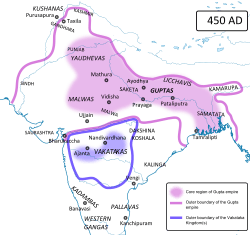Pushyamitras
The Pushyamitras were a tribe who lived in Central India during the 5th century CE. Living on the banks of the river Narmada, they are believed to have posed a serious threat to the Gupta Empire during the late period of Kumaragupta I's reign. Inscriptions covering the events between 455 and 467 CE emphasise the role of Skandagupta, Kumaragupta's successor, in defeating the Pushyamitras.[1]
By whom, when [Skandagupta] prepared himself to restore the fallen fortunes of (his) family, a (whole) night was spent on a couch that was the bare earth; and then, having conquered the Pushyamitras, who had developed great power and wealth, he placed (his) left foot on a footstool which was the king (of that tribe himself).


The Pushyamitras are only known from this inscription, of which the reading is sometimes disputed (it could be "Yudhy-amitrdths-cha" rather than "Pushyamitrams-cha"), as well as a single mention in the Puranas.[3] Therefore their existence is sometimes doubted. The people Skandagupta fought could more probably have been a confederation including the Vakatakas.[3] The dynasty of the Vakatakas ended around that time in a war, when, according to the Dashakumaracharita, attacking the area of Vanavasi to the south, they were in turn attacked from the rear resulting in the death of the last Vakataka king.
See also
- Vardhana dynasty
References
- Kulke, Hermann; Rothermund, Dietmar (2004). A History of India (4. ed.). New York [u .a.]: Routledge. p. 96. ISBN 0415329191. Retrieved 22 August 2015.
- Tripathi, Ram Prasad (1981). Studies in political and socio-economic history of early India. Neeraj Prakashan. p. 37.
- Cultural Contours of India by Vijai Shankar Śrivastava p.103